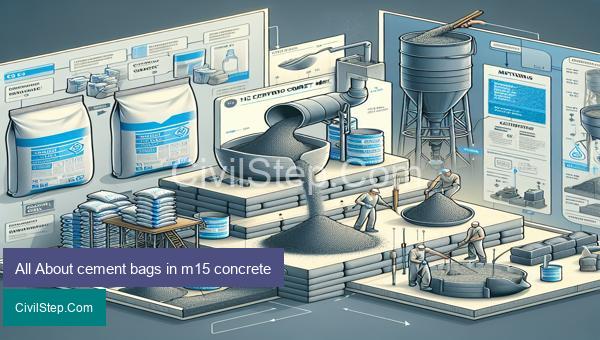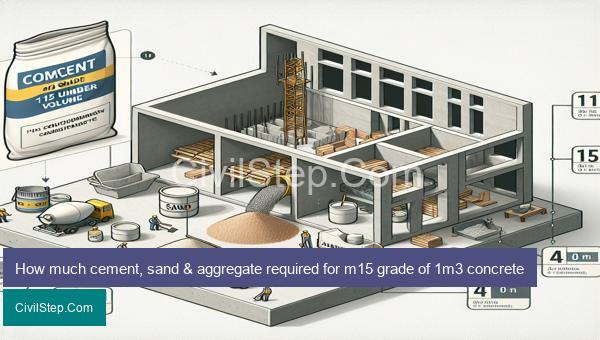
Concrete is one of the most widely used construction materials and plays a crucial role in the development of buildings, roads, and other structures. One important component of concrete is cement, which binds the mixture of sand, gravel, and water together. However, the strength and durability of concrete depend not only on the type of cement used but also the proper ratio of its components. In this article, we will delve into the details of cement bags in M15 concrete, discussing its composition, properties, and impact on the quality of concrete. Understanding the role of cement bags in M15 concrete is essential for anyone involved in the construction industry, from builders and contractors to engineers and architects. So, let’s explore all about cement bags in M15 concrete.
How many cement bags in m15 concrete

M15 concrete is a type of concrete with a compressive strength of 15MPa (megapascals), which is commonly used for residential and commercial construction projects. The strength of concrete is directly proportional to the amount of cement used in the mixture. Therefore, the number of cement bags required for M15 concrete would depend on the size of the project and the dimensions of the concrete structure.
The basic proportion of ingredients in M15 concrete is 1:2:4, where 1 represents cement, 2 represents fine aggregates (sand) and 4 represents coarse aggregates (stone). This means that for every 1 part of cement, 2 parts of sand and 4 parts of coarse aggregates are mixed.
Let us assume that the volume of concrete required for a project is 1 cubic meter. This means that we need 1 cubic meter of cement, 2 cubic meters of sand, and 4 cubic meters of coarse aggregates. To convert these volumes into weights, we need to know the density of each material.
The density of cement is approximately 1440 kg/m3, while the density of sand and coarse aggregates can vary depending on the source and type of material. Let us assume the density of sand to be 1600 kg/m3 and that of coarse aggregates to be 1800 kg/m3.
Therefore, the weight of 1 cubic meter of cement would be 1440 kilograms, the weight of 2 cubic meters of sand would be 1600*2 = 3200 kilograms, and the weight of 4 cubic meters of coarse aggregates would be 1800*4 = 7200 kilograms.
Now, using the basic proportion of 1:2:4 for M15 concrete, we can calculate the amount of cement required by dividing the weight of cement (1440 kilograms) by the sum of the weights of cement, sand, and coarse aggregates (1440+3200+7200 = 11840 kilograms). This gives us the amount of cement to be 1440/11840 = 0.122 kilograms.
In order to convert kilograms to bags, we need to know the weight of a standard bag of cement. In India, the weight of a bag of cement is 50 kilograms. Therefore, the number of cement bags required for 1 cubic meter of M15 concrete would be 0.122/50 = 2.44 bags (approximately).
In conclusion, for every 1 cubic meter of M15 concrete, 2.44 bags of cement are required. This number may vary depending on the proportions used and the density of materials. It is always recommended to consult with a structural engineer or a concrete supplier for accurate calculations of materials for any construction project.
How many cement bags in m15 concrete

M15 concrete is a type of concrete with a compressive strength of 15MPa (megapascals), which is commonly used for residential and commercial construction projects. The strength of concrete is directly proportional to the amount of cement used in the mixture. Therefore, the number of cement bags required for M15 concrete would depend on the size of the project and the dimensions of the concrete structure.
The basic proportion of ingredients in M15 concrete is 1:2:4, where 1 represents cement, 2 represents fine aggregates (sand) and 4 represents coarse aggregates (stone). This means that for every 1 part of cement, 2 parts of sand and 4 parts of coarse aggregates are mixed.
Let us assume that the volume of concrete required for a project is 1 cubic meter. This means that we need 1 cubic meter of cement, 2 cubic meters of sand, and 4 cubic meters of coarse aggregates. To convert these volumes into weights, we need to know the density of each material.
The density of cement is approximately 1440 kg/m3, while the density of sand and coarse aggregates can vary depending on the source and type of material. Let us assume the density of sand to be 1600 kg/m3 and that of coarse aggregates to be 1800 kg/m3.
Therefore, the weight of 1 cubic meter of cement would be 1440 kilograms, the weight of 2 cubic meters of sand would be 1600*2 = 3200 kilograms, and the weight of 4 cubic meters of coarse aggregates would be 1800*4 = 7200 kilograms.
Now, using the basic proportion of 1:2:4 for M15 concrete, we can calculate the amount of cement required by dividing the weight of cement (1440 kilograms) by the sum of the weights of cement, sand, and coarse aggregates (1440+3200+7200 = 11840 kilograms). This gives us the amount of cement to be 1440/11840 = 0.122 kilograms.
In order to convert kilograms to bags, we need to know the weight of a standard bag of cement. In India, the weight of a bag of cement is 50 kilograms. Therefore, the number of cement bags required for 1 cubic meter of M15 concrete would be 0.122/50 = 2.44 bags (approximately).
In conclusion, for every 1 cubic meter of M15 concrete, 2.44 bags of cement are required. This number may vary depending on the proportions used and the density of materials. It is always recommended to consult with a structural engineer or a concrete supplier for accurate calculations of materials for any construction project.
How much cement, sand & aggregate required for m15 grade of 1m3 concrete

M15 grade of concrete is a medium strength concrete used in various construction projects. It has a compressive strength of 15 N/mm² after 28 days of curing. In order to achieve this strength, the right proportion of cement, sand, and aggregate is required in the concrete mix. Let’s take a look at the calculation of the quantity of these materials required for 1m³ of M15 grade concrete.
Cement:
Cement is the most important component of concrete as it provides strength and binds all the materials together. The quantity of cement required for 1m³ of M15 grade concrete is 6.25 bags or 310 kg. The average density of cement is 1440 kg/m³, which means one bag of cement (50 kg) will have a volume of 1/1440 m³. Therefore, 6.25 bags of cement is equal to 0.43 m³.
Sand:
Sand is the second most important ingredient in concrete. It fills the voids between the coarse aggregate and acts as a filler. The quantity of sand required for 1m³ of M15 grade concrete is 0.46 m³. The bulk density of sand is 1600 kg/m³, and it covers 15% of the concrete volume. Hence, 0.15 m³ of sand is needed for 1m³ of concrete. Convert this into the weight of sand by multiplying it with the bulk density, which gives us 736 kg.
Coarse aggregate:
Coarse aggregates are the main bulk of concrete and provide strength to the concrete. The quantity of coarse aggregate required for 1m³ of M15 grade concrete is 0.87 m³. The bulk density of coarse aggregate is 1600 kg/m³ and it covers 75% of the concrete volume. Therefore, 0.75 m³ of coarse aggregate is needed for 1m³ of concrete. Its weight can be calculated by multiplying the bulk density with its volume, giving us 1392 kg.
Summary:
Material | Quantity | Weight (kg)
— | — | —
Cement | 6.25 bags | 310 kg
Sand | 0.46 m³ | 736 kg
Coarse aggregate | 0.87 m³ | 1392 kg
Note: It should be noted that the above quantities are based on the assumption that the concrete mix has a water-cement ratio of 0.5. This ratio can vary depending on various factors like the type of cement, aggregate, and climate. It is important to conduct a trial mix before finalizing the exact quantities of the materials.
In conclusion, to prepare 1m³ of M15 grade concrete, the required quantities of cement, sand, and coarse aggregate are 310 kg, 736 kg, and 1392 kg respectively. It is essential to maintain the correct proportions of these materials to achieve the desired strength and durability of the concrete. Any variation in the quantities can lead to a weaker or stronger concrete mix, which can affect the overall quality of the structure. Therefore, it is important to follow the recommended mix design and conduct quality control checks to ensure the proper proportioning of materials.
Conclusion
In conclusion, cement bags are an essential component in the production of M15 concrete. These bags provide the necessary strength and durability to create a reliable concrete mixture. With the proper handling and storage of cement bags, the strength and quality of the concrete can be maintained. It is crucial to follow the correct procedures for handling cement bags to ensure the safety and efficiency of the construction project. By understanding the role of cement bags in M15 concrete, we can ensure the successful and long-lasting outcome of our construction projects.
